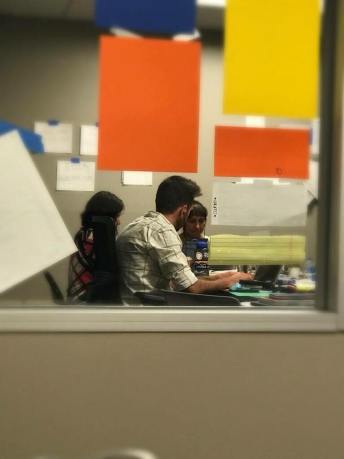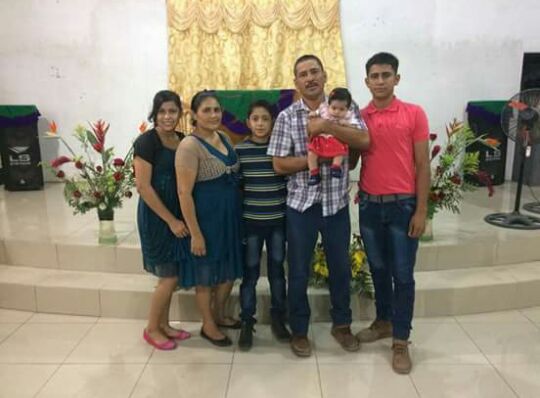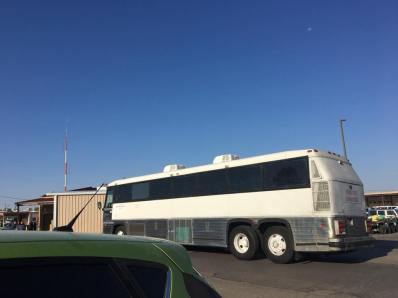
By Seth Ogilvie, Idaho Reports
A father and a daughter fled their country in fear and ended up in U.S. detention. A group of Idahoans saw what was happening and wanted to help.
“The dehumanizing practices make me ill. It’s absolute chaos,” said Molly Kafka an Idaho lawyer who recently interviewed several asylum seekers in El Paso. “The whole system is in utter chaos.”

Kafka saw the chaos first hand. She was one of five Idahoans who traveled to Texas. In Idaho, she heard that children were being separated from their parents and felt compelled to go to the border to bear witness and do what she could to help. The group of Idahoans landed in Texas, traveled across the desert and prepared for a long week in El Paso.
Hundreds of Guatemalan asylum seekers have headed to the same area, walking across a small pedestrian right of way enclosed by bars and chain link fence spanning a canal and a road they enter the United States from Juarez, Mexico. They guide their children to government agents.
“They walk up to officers and say I do not have authorization,” said Kafka. “I’m not allowed in this country. I do not have a visa or a passport to get in, but I’m afraid to return home.”
Kafka, along with her four other colleagues, interviewed mothers and fathers separated from their children while in U.S. custody the same week Trump signed an executive order to reunite families. The asylum seekers would “be taken into different rooms, and that would be the end of it. They would be told, well, we can’t keep the two of you together. Your kid is underage, and you’re an adult. We can’t have you in the same facilities.” Kafka said.

Maria Andrade, a prominent Idaho immigration attorney, was the principal organizer of the group. With her help, the team set up base at Annunciation House. They worked in a recently painted room with bare walls, folding tables, and limited chairs. On one of the walls, they hung a sheet of paper with a happy face on it. The poster was titled “Reunited Families” and had space for names. The poster had no names and remained bare and empty. “It was blank, and at some point during the week, I was like we got to get rid of this paper,” Andrade said.
Henrry Ramirez Bayes, an asylum seeker from Guatemala, had already made the roughly 2,000 mile trip from Guatemala to a detention center in Texas. He fled his home with his daughter, leaving his other family members behind.
Gangs in his home country threatened, assaulted and stabbed Bayes trying to extract his daughter from Bayes’ family. The U.S. government had separated the two of them. “We were in an office. They took our fingerprints. I was with my child, then they took us in a room that was super cold, and I was there with my daughter,” said Bayes. “They told me don’t worry, you will be separated only for five days. I had handcuffs on, so I couldn’t even give my daughter a hug. My daughter is still traumatized.”
Separated from his daughter, Bayes found himself in what is commonly called the “icebox,” both because of Immigration and Customs Enforcement (ICE) and the temperature, for twenty days. “I have nowhere to sleep. I was sleeping on the floor, I had those blankets, the silver ones. It was super cold,” said Bayes. “They don’t let you sleep, they count you every two hours, they open the doors and then slam them, everybody’s talking so there’s basically no sleep. It’s just torture, like not wanting to go on anymore.”
Bayes moved to the detention center in Otero, New Mexico, about 30 minutes from El Paso before the Idahoans arrived. “I thought it was gonna be a detention center, but it was a real jail. They had people that have committed crimes that had killed other people, so it was kind of frightening and then I realized one month had gone by,” said Bayes. “The second month we had a TV, so I knew what’s going on in the news so that’s when I realized that we were not going to be together for a while and I didn’t think we would be reunited.”
“They’re in state-issued jumpsuits, they have to line up and stand like they’re in prison. It reminded me of visiting clients in jails,” said Kafka.
Bayes had not broken any laws on his journey.
To apply for asylum, you must be physically present in the U.S. You have to walk across the bridge from Juárez, or a border crossing like it, and find a border patrol officer to start the process. Bayes wanted to protect his daughter and he put his faith in the U.S.government so she would be safe.

On July 22nd Bayes was eating in the dining area. “There were other detainees there also. During the meal, an officer announced that they were going to reunify us with our children in El Paso. I was very excited and happy. It was clear to me from their faces and statements that the other men were happy too. Some of them did not even finish eating,” said Bayes.
Bayes was excited to reunite with his daughter “I took off my uniform and changed into my own clothes,” Bayes said. “I saw that about eight of the detainees who were mostly indigenous Guatemalans were given some papers that others were not. I believe many of them cannot read or write and do not speak Spanish based on my interactions with them. The group got off the bus before the rest of us.”
Kafka and Andrade traveled to detention centers daily. “They all look like warehouses where semis would pull up and load up their beer trucks or their boxes of goods,” said Kafka. “But they’re surrounded by barbed wire fences, and the gates are locked.”
Upon entry they traveled “through a metal detector” Andrade said. She would walk down a hall to see detainees. On the wall, a giant screen with bright colors allowed people to deposit money into detainee accounts. The detainees would use that money to make phone calls, contact family members, and seek outside help on their cases. “It was so gross,” said Andrade. “It had these peppy colors and fonts.” The program was called “Getting Out.” Family and friends of detainees in the facility would walk by it as they went to the visitation room. The logo looked like the Bank of America, and it served as a stark reminder to many visitors that the likelihood any of these people would be “getting out” was slim. Andrade remembered, “I wanted to throw a rock at that.”

Bayes made the trip to El Paso. “There were 37 people on the bus. We entered a parking lot with buildings, including a detention center”, Bayes said. “We were surprised that our kids were not waiting for us. I thought that after changing into our own clothes, that we were going to be released from custody. Instead, we were put into the icebox.”
Bayes had been in the icebox before, shortly after being separated from his daughter weeks before. He started the journey to U.S. asylum because Guatemalan gangs wanted his daughter. “He came because people are trying to buy his daughter. They got death threats because people wanted his daughter,” Andrade explained. “Graffiti on a wall next to his family home said ‘give us your daughter or you will die.’”
“I came to this country asking for asylum because my daughter was in danger,” said Bayes. “I left my other son, and I just brought my daughter that was in danger. [It’s] because of my daughter I’m here.”
The group from Idaho would meet parents separated from their children in small rooms separated by plexiglass. The rooms were white with accents of gray. They had fluorescent lights that created a constant hum. Volunteers would get headaches from the hum. The rooms were filled with flat, stagnant air that smelled like sweat, “death threats and anxiety,” Andrade said. Developing a rapport in the small rooms was difficult. “We were asking people to trust us after our government has so violently torn them apart from their children and placed them here,” said Kafka. The interpreter Max Shue would “have his ear up to the speaker and the other person had to be at the speaker as well,” Kafka added. “It was a really difficult place to communicate.”

Bayes spent the next day in the detention center. Eventually, officers started to remove detainees one by one. The group thought the moment had finally come. They would finally see their children. “Everyone was so happy, and there was loud clapping in celebration when the first person was called,” Bayes said. After several people had been called out of the room by officers, a group of detainees peered out the window to the yard outside the building. The busses were parked outside. The asylum seekers they thought had just been reunited with their children were standing outside. “I saw him outside of the building, walking to the bus in handcuffs,” Bayes said. “He was not with his child. He had a chain around his waist, and his wrists were cuffed together.”
Many of the men broke. The shock of being moments away from their child only to be led back to detention again was too much. “People got depressed. Others started crying. Some had a meltdown and they had to go to a doctor, so it is really bad,” said Bayes. “People were crying. It was horrific.” Andrade said men recounting the event were “trying to be strong, on the brink of tears or they would just break down crying. One man, I thought he was mentally decomposing.”
Another man told Andrade “I don’t want him (his child) to think I left him. I didn’t want this. I loved him. I’m ready to go, but I can’t leave without talking to him. I’m not going to leave him.”
The asylum seekers miss their children. They thought they were bringing them to a better place, but now they feel duped. “They have this incredible sense of guilt,” Andrade added. “They feel like they were responsible for this.”
Kafka said gangs had recruited many of the people she interviewed. If families rejected the groups, those families were at risk. Some would report the gangs to the police, but “because the police are working for the gangs, people would end up being shot,” Kafka said. “It is consistent harassment and terrorizing tradition of not wanting to participate in criminal activity and then having to flee because the government is not protecting you. Police aren’t protecting you. You don’t say no to the cartels without deadly consequences.”
Bayes was sent back to Otero the next day. “On the return bus, some people asked the bus driver why we were being sent back without our kids, but they told us that they did not know,” said Bayes. “No ICE officer or other immigration official told us why we were being returned.”
Some parents and kids reunited. Adults and children went into a large room outside the detention center. “It was completely disorganized. It was so clear that they had no idea what they were doing,” Andrade heard from parents in the room. “Kids crying, looking for their parents. [Some] can’t find their parents, walking through this path of adults. Parents looking for their kids thinking they’re seeing their kids. It’s so clear they couldn’t care [less] about the trauma.”
The parents that found their children boarded a different bus. The bus left the center with parents finally talking to their children after long separations. Shortly after leaving the facility, the bus stopped. Government officials boarded the bus with documents in hand. The parents were asked to sign the papers, according to multiple accounts and an ACLU lawsuit. On the form, “I’m going to be deported with my child was pre-checked,” according to Andrade.
Many of the parents and children on the bus didn’t want to sign, but they didn’t want to leave their kids. Parents cried not wanting to lose their sons and daughters again. “They’re being told you have to sign here,” Andrade said. “One witness tells us about a parent and a son fighting because the son says ‘I think I have a claim. Someone told me I had a good case.’ The fathers like ‘no, you have to come with me.’”
The older kids were able to explain their position to their parents. They had a good chance at being granted asylum. They didn’t want to self-deport, but they also didn’t want to leave their mom or dad again. Only eight people didn’t sign the self-deportation order.
An ACLU lawsuit about the incident describes “coercive and misleading” actions by the U.S. government.
“They were presented with three different forms, and they were asked to sign them,” Kafka said. “The ICE officer picked up the stack of papers and picked up the right corner and said ‘sign here, sign here,’ without showing them.” The forms were all in English and no translation was offered. If asylum seekers refused to sign, they would be “yelled at and ridiculed and mistreated,” Kafka said.

Bayes returned to the detention center without his daughter. “This experience was very traumatic for me. I was so excited to see my daughter and be with her again after not seeing her for almost two months now,” said Bayes. “My daughter is 15 years old. She turned 15 just before we arrived.”
Another member of the Idaho team was Naomi Johnson. “My purpose in going, as a clinical social worker, was to assist in instances of vicarious trauma,” said Johnson. “I ended up spending most of my time attempting to locate children after they had been removed from their parent(s).”
Johnson tried to find Bayes’ daughter. She was able to make contact with the person responsible for the daughter. The representative told Johnson that the daughter was released. “A child was supposed to be tracked by the Office of Refugee Resettlement, we started seeing that the legal representative had signed a release of the child [and] had put the child on a bus and didn’t know where the child was,” said Kafka.
“When I talked to them they said to their knowledge the child had been reunited eight days prior to our conversation,” Johnson said. “I explained that they were not reunited [and] that the father had no idea where his child was.”
“We’d be like the (expletive) they have,” said Kafka. “They’re in the detention facility! Where’s the child? What’s going on? Can you imagine being in this country, being in a foreign country, and losing your child? Intentionally, absolutely intentionally, they have a database.”
The U.S. government lost Bayes’ daughter.
“I had to tell him that according to the government, his daughter and he had been released. I mean to see his face. He knows what could happen. They don’t (expletive) know where she is. Where’s his daughter? He came because people are trying to buy his daughter,” Andrade said. “They got death threats because people wanted his daughter.”
Andrade and Kafka eventually had to return to Idaho. They turned over Bayes’ case to other lawyers and Johnson turned the search for his daughter over to other caseworkers.
Back at the detention center, Bayes started to receive this new assistance. Then one morning, he got a phone call. His lawyer said you’re going to be released, but Bayes didn’t believe it “because of the things that have been happening.”
The volunteers didn’t stop trying to track down his daughter and get Bayes out of detention.
Eventually an immigration officer told Bayes he was going to be released, but first, he had to sign some documents. Bayes said “I was doubting if I should sign, but I just wanted to leave that place, so I signed. I don’t know if that’s going to help me in my case or hurt me, but I just wanted to be released, so finally I saw my daughter after three months, and that was the best thing that happened to me.”
Bayes and his daughter are now in the United States, outside the walls of a detention facility. They are currently waiting for their asylum hearing. Their long journey away from violence is temporarily over, but the trauma they experienced still lingers.
His daughter was not the same. The experience had affected her mentally and physically. “She doesn’t trust me anymore, she thinks I’m going to leave her again,” said Bayes. “When I go out to the store, I tell her I’ll be back, and she looks at me like ‘I don’t trust you, you’re going to leave me again.’ It breaks me because of what she went through, so after I have money I’m going to send her to a psychiatrist because she’s not right.”
The experience has had a physical toll on Bayes’ daughter. He remembers her having her period before they left for the United States but “after we got out of the detention she hasn’t had her period for two months,” said Bayes “I’m very afraid that they touched her or raped her.”
Stress can cause irregular or missed periods. The condition is called secondary amenorrhea.
Now that they are back together, Bayes says his only priority is his daughter. He is going to do whatever it takes to give her a better life because “my life doesn’t matter, it’s her life,” said Bayes.
In 2017, then-Secretary of Homeland Security John Kelly proposed separating children from their parents to deter people from traveling to the border. Had Bayes known what was in store for him, the deterrence may have worked. “I would not do it again if I knew how difficult it was going to be, being separated from my daughter. I would not have done it,” said Bayes. “I would have gone to another country and asked for asylum in another country because it was really harsh.”






